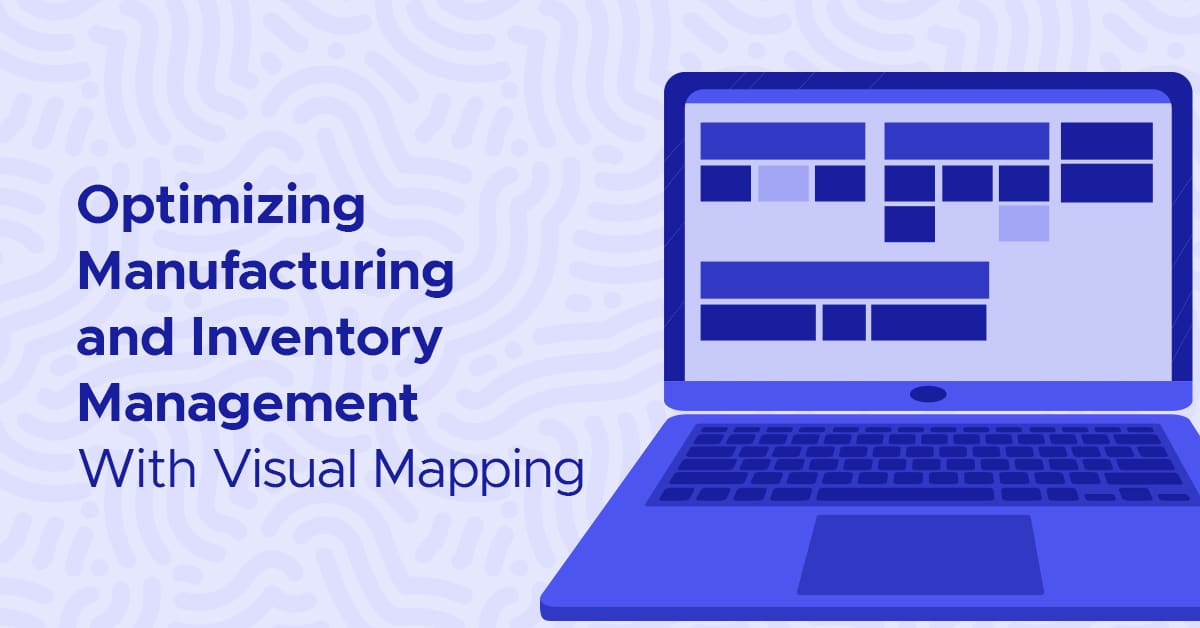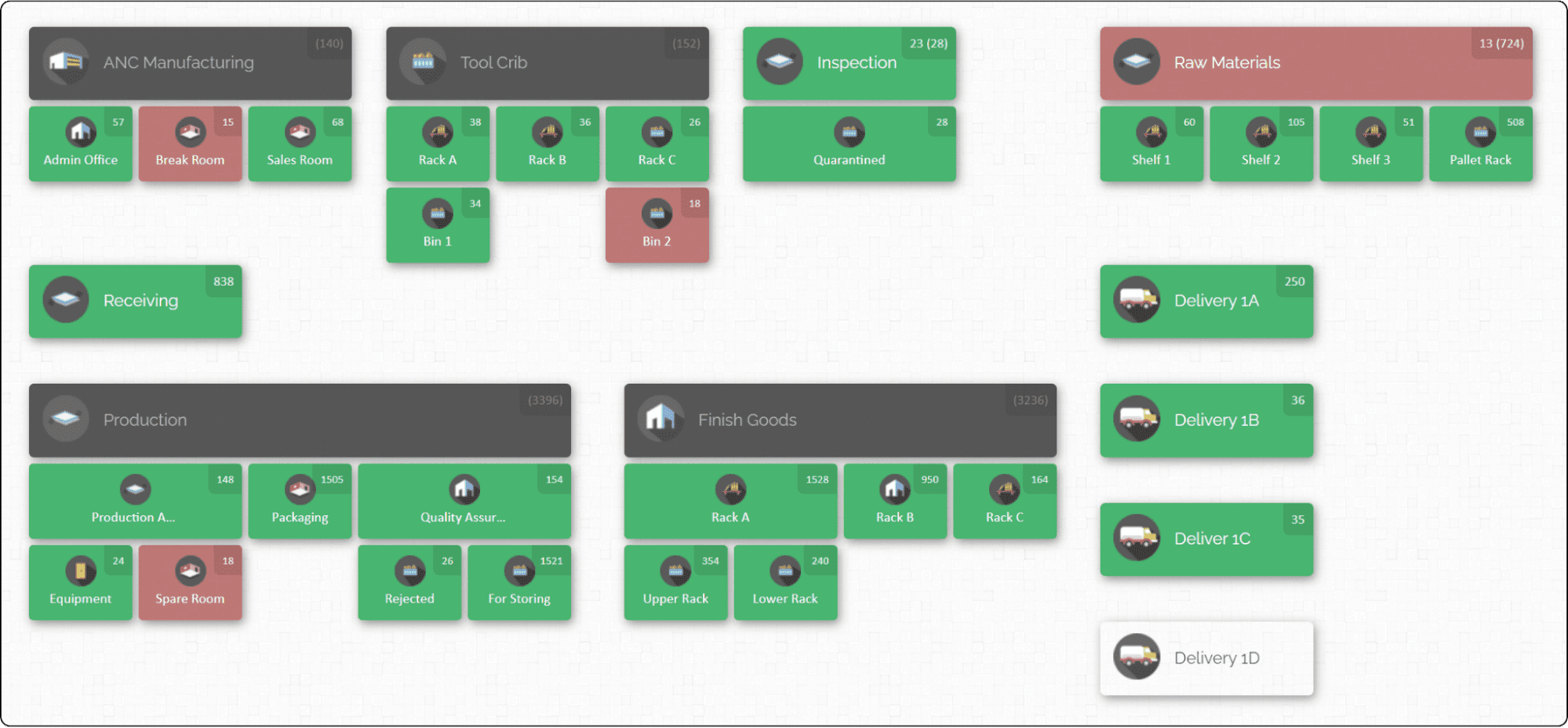
Benefits of Inventory Visibility: Optimizing Manufacturing and Inventory Management

This is a guest post from Claude Rivera. Claude is a channel manager at CyberStockroom, where she specializes in empowering businesses to overcome the challenges of inventory management through innovative software solutions. With a focus on the needs of companies that manage field inventory, Claude and her team offer a robust SaaS platform designed to simplify and streamline inventory processes. Her dedication to assisting inventory managers and business owners comes from a deep understanding of the operational hassles they face daily.
Efficiency is crucial in manufacturing. Visual mapping is one of the largest benefits of inventory visibility and is a revolutionary solution rapidly gaining popularity in the industry.
Visual maps offer manufacturers an unparalleled level of insight into and control over their production processes and inventory. That includes tracking progress through each stage of manufacturing until the final products are ready to be stored in a warehouse or enter the supply chain.
This article will explain the benefits of inventory visibility and challenges of this innovative technology, as well as how to incorporate it into your own manufacturing business for more organized and streamlined production.
Benefits of inventory visibility — The map
A warehouse map depicts the production floor, complete with workstations, storage areas, and paths for moving inventory in great detail.
With improved interdepartmental cooperation, rapid decision-making, and effective inventory management, this display significantly increases visibility throughout the whole manufacturing process.

A manufacturing demo map from CyberStockroom
Thanks to these real-time insights into inventory levels and movements, manufacturers can:
- Optimize workflows,
- Minimize bottlenecks, and
- Improve overall operational efficiency.
The benefits of inventory visibility also enable the easy identification of potential issues or inefficiencies in the manufacturing process.
By visualizing the flow of materials and goods through the production line, companies can quickly hone in on areas that require improvement, such as refining layout designs, adjusting inventory storage locations, or streamlining task flows.
In turn, this proactive approach helps manufacturers maintain responsiveness to changing market demands and supports higher productivity and profitability.
Visual map inventory management empowers businesses to gain a competitive edge by:
- Enhancing operational efficiency,
- Reducing costs, and
- Improving customer satisfaction.
The benefits of visual map inventory management in manufacturing
Incorporating visual map inventory management into manufacturing operations unlocks many advantages that improve productivity, accuracy, and overall performance.
Benefits of inventory visibility and monitoring
Inventory maps provide a comprehensive view of stock levels for all items, including raw materials, work-in-progress, and finished goods.
That oversight allows for real-time monitoring, which facilitates better decision-making and optimal resource allocation.
Workflows and cycle times
Visual mapping of manufacturing processes and inventory locations can help companies streamline workflows.
That enables personnel to identify bottlenecks easily, optimize material flow, and reduce unnecessary movements, which then reduces cycle times and increases productivity.
Inventory organization and optimization
Manufacturers can refine their inventory organization with visual maps based on demand, shelf life, and production requirements. This minimizes stockouts, overstocking, and obsolescence.
Space utilization
Manufacturers also gain a bird’s-eye view of their physical facility layout thanks to inventory visual maps. The benefits of inventory visibility helps them make the most of their available space and arrange inventory locations efficiently.
By optimizing storage configurations, companies can reduce wasted space, increase storage capacity, and quickly adjust to fluctuating inventory levels without needing more area. This enhances operations and reduces costs for greater efficiency.
Onboarding and training process
Visual inventory maps can simplify the onboarding process for new employees as well as facilitate training for existing staff. These maps have clear and intuitive layouts that enable personnel to familiarize themselves quickly with inventory locations, production workstations, and processes. That significantly cuts down on the time and resources required for training initiatives.
Mapping inventory and manufacturing processes
Companies can introduce the benefits of inventory visibility into their operations through physical mapping and visualization software.
Physical mapping
Physical mapping facilitates smooth operations in a manufacturing facility by clarifying visibility of the production floor. You can implement physical mapping through:
- Floor markings: Marking different regions of the facility with colorful tape or paint makes it easier to tell where inventory should be placed.
- Signage: Strategically placed signage installed throughout the warehouse communicates where merchandise is supposed to go and how to handle it.
- Labels and barcodes: Labeling each piece of inventory and tracking it with barcodes helps you verify that everything is in order.
Visualization software
An inventory and manufacturing visual map is a graphical tool that represents a business’s daily operations. It depicts a manufacturing facility’s layout, showing the location of each manufacturing process, as well as how products and materials are distributed within the warehouse or facility.
Inventory map software is helpful for outlining manufacturing processes like receiving products, picking, packing, and logistics. Businesses can then follow the flow and record their everyday footprints.
Being able to detail inventory and manufacturing processes is a unique feature that’s not commonly found in most software but is highly sought after due to its potential to boost stock visibility and operational efficiency.
Using an inventory map enables you to locate items in your storehouse quickly, reduces the time it takes to pick and pack orders, and optimizes your warehouse layout.
Implementing visual maps in manufacturing facilities
The benefits of inventory visibility play a pivotal role in modern manufacturing facilities. The visual maps provide a clear and intuitive representation of the entire production process.
Here’s a comprehensive look at how manufacturers can introduce visual maps to hone their operations:
- Map production workflow: Start by capturing the entire production workflow, from raw material intake to finished product assembly. Use the visual map to delineate each step of the process, including workstations, machinery, and material flow.
- Inventory management: Track inventory levels in real time throughout the manufacturing facility with a visual map. Designate specific storage locations for raw materials, work-in-progress (WIP), and finished goods, and visually represent inventory levels.
- Resource allocation: Distribute resources such as manpower, machinery, and tools more efficiently by visualizing their utilization across different production areas. Identify underutilized assets and optimize resource allocation to maximize productivity and minimize downtime.
- Quality control and compliance: Implement visual checkpoints and quality control stations at critical junctures along the production line. Use the visual map to mark inspection points, testing areas, and quality assurance procedures. By integrating quality control measures into the visual map, manufacturers can ensure adherence to regulatory standards, detect defects or deviations early in the process and maintain product quality consistency.
- Continuous improvement initiatives: Foster a culture of continuous improvement by applying visual maps to identify opportunities for refinement and innovation. Also, encourage employees to provide feedback and suggestions for enhancing processes on the visual map. Visual maps thus serve as dynamic platforms for collaboration and idea-sharing, enabling cross-functional teams to work together to achieve common goals. Regularly review and update the visual map to reflect ongoing process optimizations and organizational changes.
Overcoming challenges and obstacles when transitioning to inventory visibility management
Various challenges and potential pitfalls can arise in the implementation of inventory visibility management. However, manufacturing businesses can introduce this method into their operations with minimal friction by taking proactive measures and applying best practices.
Below are the typical problems encountered and some suggested solutions:
- Resistance to change: Staff members used to conventional procedures may resist the adoption of a visual map-based inventory system. So, companies should run training programs that educate employees on the features and advantages of the new system.
- Data accuracy and integrity: Maintaining up-to-date and reliable data is essential to the effectiveness of visual map inventory management. To guarantee consistency and credibility, businesses should set up robust data validation procedures and audit inventory records on a regular basis.
- Integration complexity: It can be difficult to incorporate visual map inventory management into existing systems, especially in large production facilities with a variety of software programs. Embracing appropriate integration platforms and seeking help from professional IT specialists can greatly expedite this process.
- Scalability challenges: Solutions for visual map inventory management should be customizable and scalable without sacrificing efficacy or performance to handle expanding inventories and changing production requirements.
- Security concerns: The digitization of sensitive inventory data requires strong cybersecurity measures. Set access controls and encryption methods to protect against illegal access and data breaches.
- Maintenance and updates: Inventory management systems with visual maps need routine maintenance and upgrades to function correctly, so schedule regular checkups and stay on top of software updates and patches to reduce downtime and maximize system performance.
Benefits of inventory visibility — Transforming manufacturing through innovation and emerging trends
As manufacturing evolves, new technologies and practices are shaping the industry’s future. Here are some notable trends and innovations that could benefit from the application of visual mapping:
- Sustainable manufacturing practices: Concerns about environmental sustainability are prompting manufacturers to adopt eco-friendly production methods and materials. Visual map inventory management systems aid resource tracking, waste minimization, and compliance with sustainability standards.
- Personalization: Changing consumer preferences drive demand for customized products. Visual map inventory management supports flexible manufacturing processes, which allows manufacturers to meet customer needs through individualized product configurations.
- Collaborative robotics: Collaborative robots (cobots) enhance manufacturing efficiency and safety by working alongside human operators. Visual map inventory systems facilitate the seamless integration of cobots into production workflows, promoting collaboration on the factory floor.
- Digital twins: This technology creates virtual replicas of physical assets for simulation and optimization. Combining visual map inventory management with digital twin platforms uncovers real-time inventory insights and facilitates predictive maintenance.
- Cloud-based manufacturing platforms: Cloud-based platforms offer scalable solutions for production operations, data analytics, and collaboration. Visual map inventory management leverages that infrastructure to access inventory data anytime, anywhere so manufacturers can make informed decisions promptly.
- Regulatory compliance and quality assurance: Stringent regulatory requirements and quality standards necessitate strict adherence and quality control measures. Visual map inventory systems include features for tracking compliance documentation, conducting audits, monitoring quality control processes, mitigating risks, and ensuring regulatory adherence.
Wrapping up — The benefits of inventory visibility paint a clearer picture in manufacturing
The benefits of inventory visibility include greatly aiding the management of a factory or manufacturing business. They outline what occurs in a facility and help you identify and address problems before they escalate.
With the support of that real-time information, you can make informed decisions that save time and improve productivity, including:
- Organizing inventory more efficiently
- Optimizing the use of available space
- Simplifying onboarding and training processes
By adopting visual maps, factories and manufacturing businesses reap the benefits of inventory visibility by becoming more agile and adaptable to the ever-changing market. That, in turn, improves operational efficiency and long-term sustainability.


